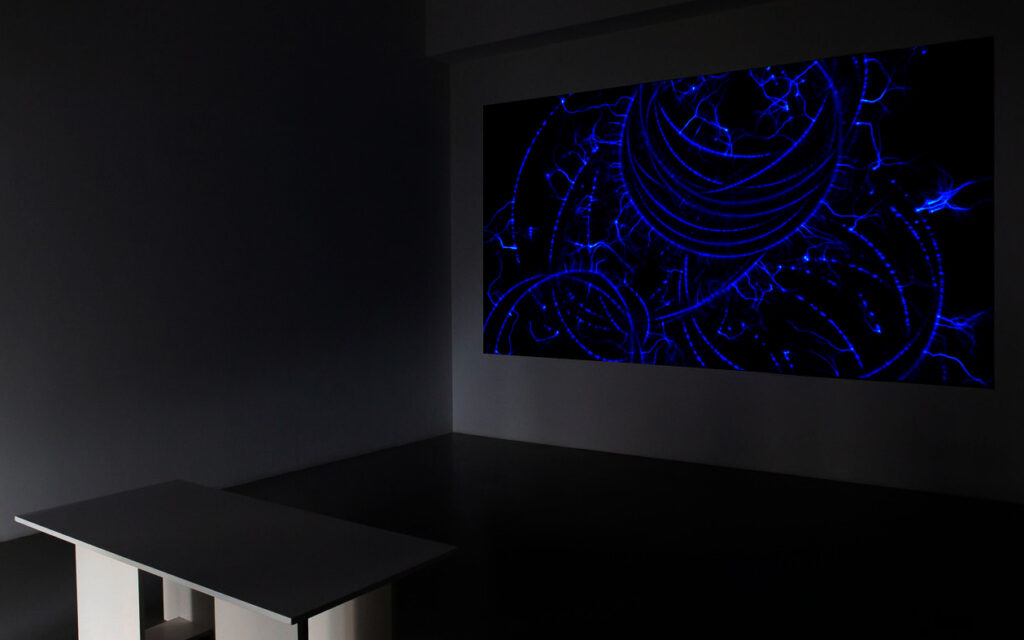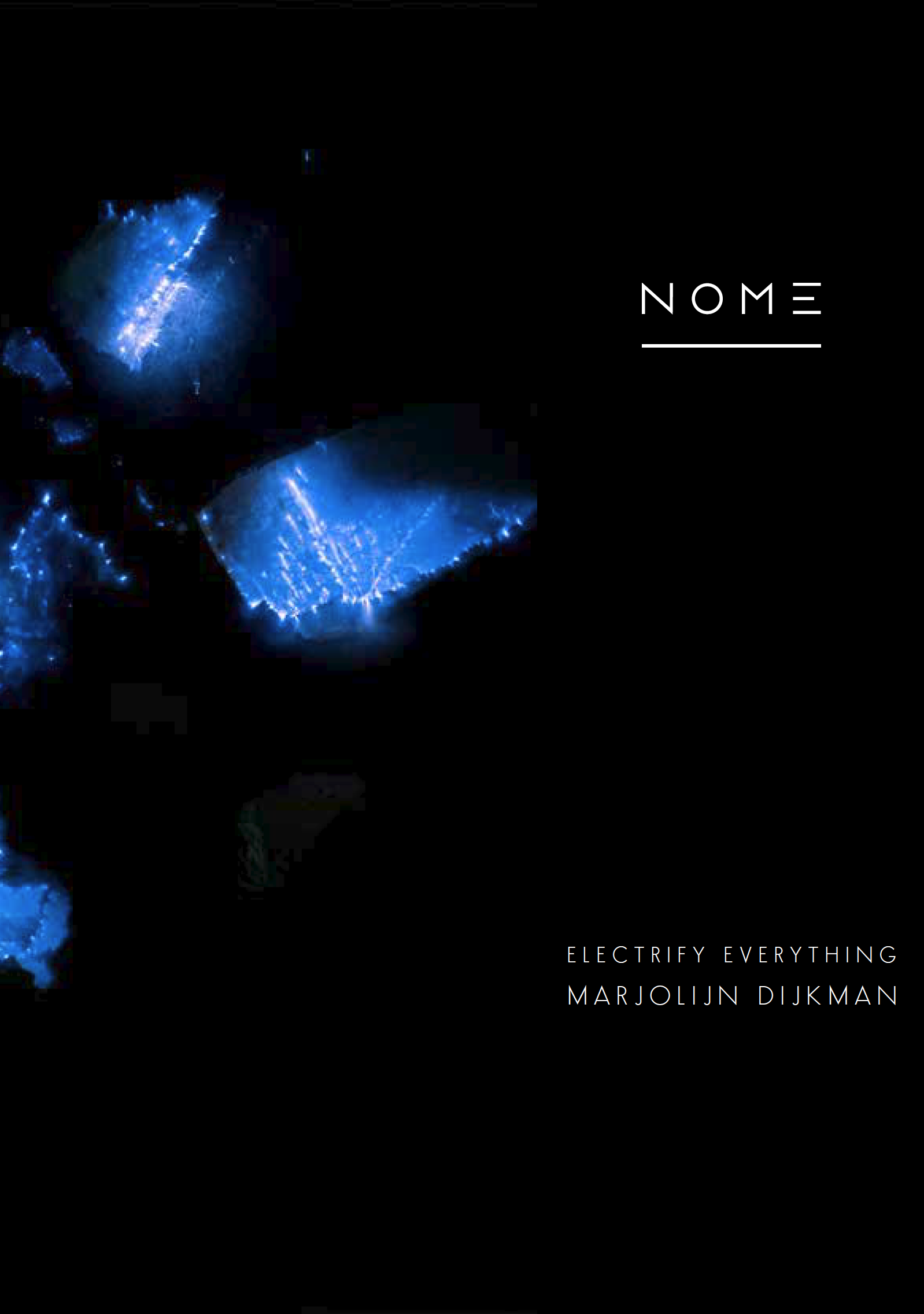Essay
Galit Eilat
 ‘Depth of Discharge’, Marjolijn Dijkman, installation at NOME, photo by Billie Clarken (2021)
‘Depth of Discharge’, Marjolijn Dijkman, installation at NOME, photo by Billie Clarken (2021)
Electrify Everything has a seductive and meticulous appearance; it presents photographs of glowing objects that look like exotic jewels, or perhaps a simulation of a future colony on Mars? A mound made of sea sand occupies part of the gallery floor, bedding small objects with an otherworldly look that resembles archeological finds of an extinct culture. Next to the sand’s mound, two transparent pyramids are placed on black pedestals, and each one protects artificial petrified lightning.
The photographs’ mesmerizing colors, the petrified lightning’s sparks, and the restrained, elegant hanging of Electrify Everything are misleading or, better said, are an illusion. The energy consumption and the high voltage Marjolijn Dijkman employed in creating the images and objects in the exhibition are highly dangerous and deadly.
Electrify Everything looks subdued, but within you see suspended electrified energy. The question that accompanies Dijkman’s current research is: Why are so many metaphors donated from the world of electricity? Metaphors represent emotions, relationships, social changes, and political revolutions. Why is electricity, in particular, an integral part of our imagination? And why is electrical energy perceived in a positive light while the production of electricity is perceived negatively?
One of the concepts that Western philosophy has inherited, and that we still suffer from, is the separation between body and mind, between the mechanical-physical machine and the subjective-mental machine. In the 17th century, Rene Descartes (1) argued that a separation should be made between body and mind. In his doctrine, the human body is composed of different parts while the brain is a unit that cannot be divided. He argued that there is nothing in common between physical bodies interpreted in space and the human psyche; whose essential feature is thinking. He separated the body from the mind so that the mind would not be submissive to the laws of mechanics, which he saw as ruler of the physical world. The Cartesian pattern of thought accompanies in one way or another most of the philosophical traditions, even those that do not consider themselves dualistic. Different types of dualism have emerged due to this separation and now accompany the cognitive sciences. For example, the separation of information from matter, between a function and its physical application, or between energy and production. Marjolijn Dijkman opposes this dichotomous division and asks us to relate the electromagnetic, electrical, chemical, and biological processes to the way they work. There is an essence that activates them; the mind, the mindset, and the ideology that created or invented them. It turns its back on the dualism created by Descartes between matter and thought, between body and mind, and between the individual and the environment.
By the end of the 80s, no special emphasis was placed on metaphors in language study. It was assumed that metaphors were meant to add a colorful or stylistic touch to a text or speech. This assumption changes following the publication of several studies; George Lakoff and Mark Johnson (2) argue that a metaphor is first and foremost a means of understanding and representing an interest or concept. Metaphors exist when concepts from one field, the field of purpose are represented by concepts from another domain; the source domain. “Chin up;” “The descent is at the foot of the mountain;” “Head of the class.” Usually, the concepts of purpose such as the spatial concepts in the examples above are abstract and therefore require metaphors, and the concepts of origin, like the body organs in the examples above, are tangible. Michael Reddy (3), found that abstract concepts of communication and ideas are understood through a conceptual metaphor. For example, feelings are fluid, especially anger as a liquid under pressure within a vessel, or “I’m so angry I’m boiling,” when we are emotionally exhausted we feel “empty,” and those who worked hard are likely to suffer from a “burnout.”
 ‘Depth of Discharge’, Marjolijn Dijkman, installation at NOME, photo by Billie Clarken (2021)
‘Depth of Discharge’, Marjolijn Dijkman, installation at NOME, photo by Billie Clarken (2021)
Depth of Discharge (4) is viewed in a black box, the projection is the only form of light and delivers sequences of energetic interactions, which create a visual spectacle in thousands of shades of monochromatic blue. The frequency of the sound and image creates a mesmerizing experience, giving the feeling that both the frequencies of the brain and the film are synchronized into one. The scientific use of the term Depth of Discharge is associated with the life of a battery. The life of the battery is measured by its ability to recharge.
Depth of Discharge was created by high voltage photography where the electricity and electrified objects became the protagonists and the discharge of the drama. In Dijkman’s black-out studio, she documents a process of Corona Discharge,(5) which creates a glowing aura caused by ionization and an electrical disturbance caused by contact with air. The discharge is captured through a touch screen, which originates from smartphones and other flatscreens. The film depicts modern empires based on minerals’ energy economies. The symbols in the film are taken from a table of standard electrical units and reveal the metaphors associated with utopia and electrical dystopia. Concepts related to the electric sign language indicate the ideals that the symbols represent beyond their technical meaning.
What do you see before your eyes when you read the phrase Corona Discharge? Beyond the technical significance, it can be said that many crowns have been attached to the corona in the last two years, and indeed it is time to separate from the corona. The technical description would be electric discharge caused by liquid ionization like the air around an electrically charged conductor.

Cloud to Ground, Marjolijn Dijkman, installation at NOME, photo by Billie Clarken (2021)
The development of electricity has been marked by historians as the second industrial revolution, although the energy derived from electricity has been known since ancient times. Benjamin Franklin is considered to be the man who harnessed electricity to the Industrial Revolution. Since the experiments Franklin conducted in the 18th century, dependence on electricity has only increased. The great breakthrough in electricity occurred in the early 19th century when the British scientist Michael Faraday (6) discovered the basic principles of electricity generation. Based on the experiments of Franklin and others, he noticed the ability to “generate” an electric current by moving magnets inside coils of copper wire. It was this experiment that led to the discovery of electromagnetic induction which later paved the way for the utilization of electricity as the main energy source.
“A metaphor is the energy charge that jumps between the images, revealing their connections.”(7)
Benjamin Franklin’s scientific contribution to electrical energy is minor, and his acumen as a businessman (8) likely surpasses all of his other inventions. Franklin hypothesized that an electric charge flows and is transferred from one body to another as an investor. Excess “electricity” is expressed in a positive charge and a deficit of “electricity” in a negative one. The symbols remain today, and the metaphors are associated with excess as a positive concept and lack as a negative concept. (9)
From the mythological Prometheus until the middle of the 18th century, the phenomenon of lightning remained an unsolved riddle. In 1749 Franklin detailed in his diary the resemblance between an electric spark and lightning: both emit light of the same color, and both have a winding trajectory and rapid motion. Both pass through metals that cause noise, break objects they encounter, kill animals or humans and ignite flammable material. Most of the things he described were already known at that time; the innovation was in the last sentences on his list. “The electric fluid is attracted to pointed objects; we do not know if the same feature exists for lightning. But since they are equal in all other comparable details, why should this feature not act the same way? An experiment can be determined!” The number of victims who were killed in this experiment is unknown, and Franklin did not remember to add this important fact. (10)
At the end of the 19th century, much of scientific discoveries and inventions entered a new phase: a prominent example of this is the invention of the electric light bulb, which is considered one of Thomas Edison’s most important inventions. (11) Another equally important invention was the establishment of the first institution whose stated purpose was to produce technological innovations and regular improvements. Although the innovations for which Edison won the patent were not unique, Edison possessed a unique ability to register patents and a successful marketing talent that led to the defeat of his competitors.
The development of inventions continued into the 20th century and the following sequence shows the rate of advancement: the battery, dynamo, spectroscopy, the construction of a power station, telephone exchanges, radio, telegraph, phonograph, moving image, gasoline engine, steam turbine, airplane, computer, the internet, communications satellites, cell phones, and in the 21st century, nuclear power plants, bombs, and target weapons were added. Probably one of the most important inventions of the Enlightenment was the invention of inventors. Depth of Discharge is an allegory for a society that created a culture of monopolies and entitlement in the name of progress and education, a society whose hubris blinded it.
Without glass, electric lighting would not reach every home; the invention of glass does not fall short of the importance of electrical energy. Not only did the glasses open people’s eyes but also their minds, seeing was believing. In his book Technique and Civilization,(12) Lewis Mumford writes that the use of glasses gave validity to the authority of the eye. It has become an organ that dictates Western culture to this day. If the axiomatic basis of modern empiricism is “seeing is knowing,” the telescope and microscope are the avant-gardes of the Enlightenment movement. Another influence of the glass that left its mark from the 17th century to the present day was the influence on architecture, this influence can be seen most clearly in the Dutch houses, with large open windows. In the Netherlands, the use of glass and its many applications went further than in other countries, and the outgoing verb of “sharper vision”; a sharper interest in the outside world was enhanced. The glass served as the peephole through which the new world was seen, but the light at the end of the tunnel simulates a lightning strike on the sea sand.
_
(1) Meditations on First Philosophy.
(2) George Lakoff and Mark Johnsen, Metaphors We Live By (London: The University of Chicago Press, 2003)
(3) (Michael J. Reddy, “The Conduit Metaphor: A Case of Frame Conflict in Our Language About Language,” Metaphor and Thought, ed. by Andrew Ortony (Cambridge: Cambridge University Press, 1979)
(4) https://en.wikipedia.org/wiki/Depth_of_discharge
(5) https://en.wikipedia.org/wiki/Corona_discharge
(6) https://en.wikipedia.org/wiki/Michael_Faraday
(7) Robin Morgan, Anatomy of Freedom (New York: Anchor Doubleday Press, 1982)
(8) The Protestant Ethic and the Spirit of Capitalism argue that Puritan ethics and ideas influenced the development of capitalism. Religious devotion, Weber argues, is usually accompanied by a rejection of worldly affairs, including the pursuit of wealth and possessions. To illustrate his theory, Weber quotes the ethical writings of Benjamin Franklin: “Remember, that time is money. He that can earn ten shillings a day by his labor, and goes abroad, or sits idle, one half of that day, though he spends but sixpence during his diversion or idleness, ought not to reckon that the only expense; he has really spent, or rather thrown away, five shillings besides. […] Remember, that money is the prolific, generating nature. Money can beget money, and its offspring can beget more, and so on. Five shillings turned is six, turned again is seven and threepence, and so on, till it becomes a hundred pounds. The more there is of it, the more it produces every turning, so that the profits rise quicker and quicker. He that kills a breeding-sow, destroys all her offspring to the thousandth generation. He that murders a crown, destroys all that it might have produced, even scores of pounds.” https://www.marxists. org/reference/archive/weber/protestant-ethic/
(9) https://lib.cet.ac.il/Pages/item.asp?item=10833&source=522
(10) https://lib.cet.ac.il/Pages/item.asp?item=10833&source=522
(11) https://en.wikipedia.org/wiki/Thomas_Edison
(12) Mumford Lewis, Technique and Civilization (London: Routledge & Kegan Paul Ltd, 1955).

____
